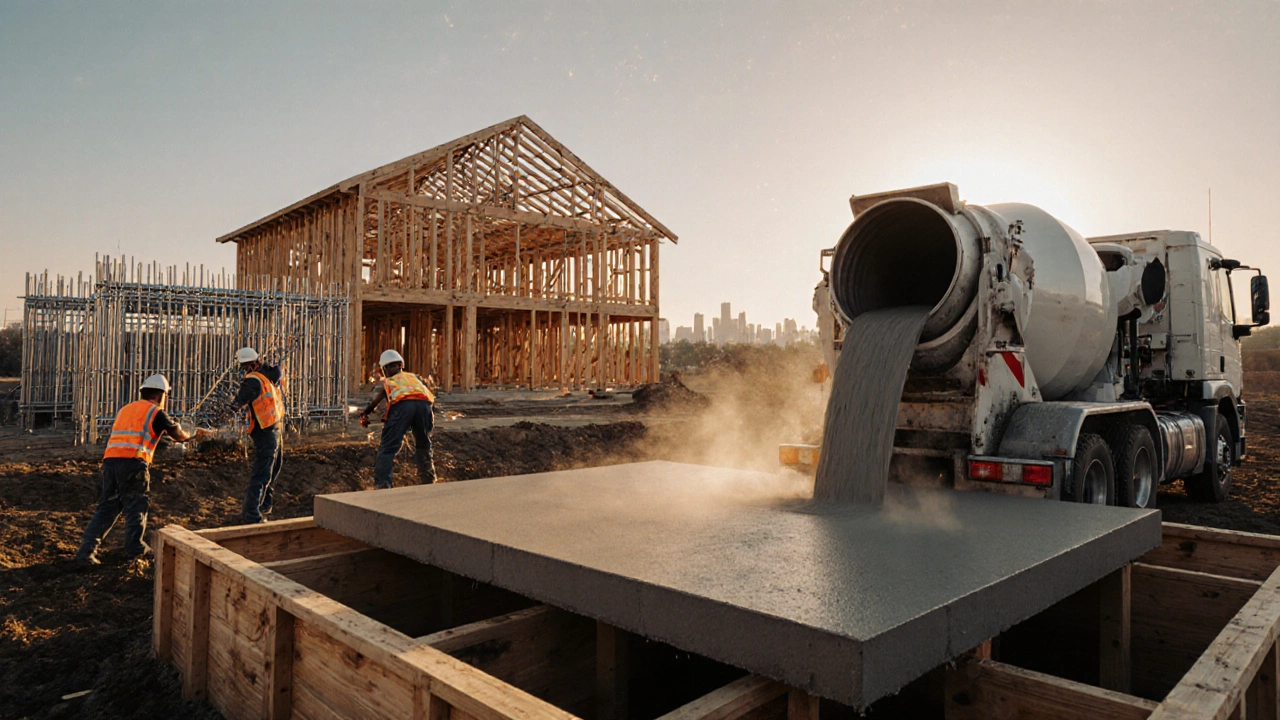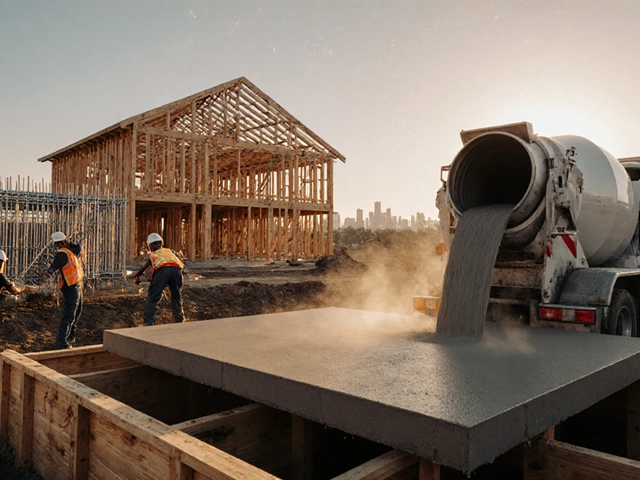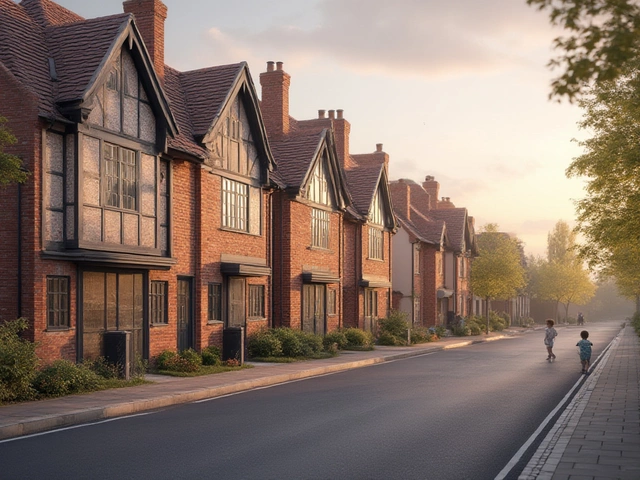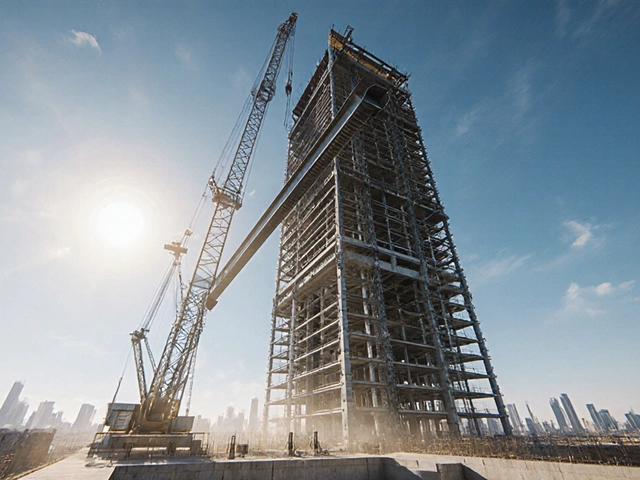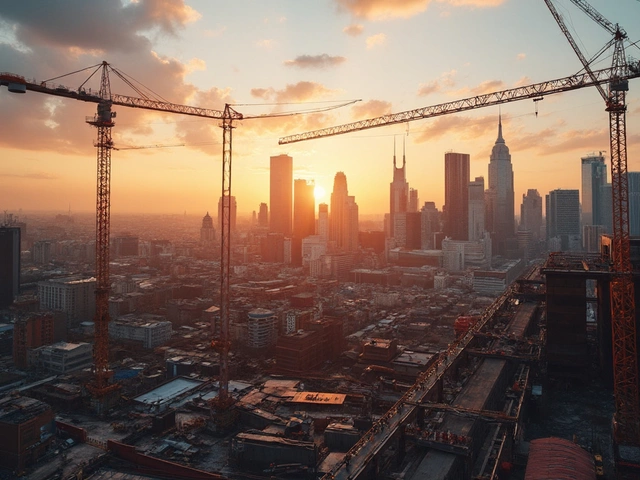Construction Material Selector
Select a Material:
Material Details
Key Properties
- Compressive Strength: -- MPa
- Tensile Strength: -- MPa
- Average Cost: --
- Best Use Cases: --
Strength Comparison
Comparison Table
| Material | Compressive (MPa) | Tensile (MPa) | Cost |
|---|
When you walk onto any building site-whether it’s a suburban home, a high‑rise office tower, or a city bridge-you’ll see the same handful of raw supplies showing up again and again. Knowing which materials dominate the industry helps you read plans, estimate costs, and make smarter decisions for your own projects.
Quick Takeaways
- Concrete, steel, and wood together account for roughly 70% of the volume used in new construction.
- Each material brings a distinct mix of strength, cost, and environmental impact.
- Choosing the right material starts with understanding load requirements, climate, and budget.
- Modern additives and recycling are reshaping the traditional hierarchy of material popularity.
- Use the comparison table below to match material properties with your project’s needs.
Why These 10 Materials Matter
In 2024 the Canadian Construction Association reported that the ten items listed below formed the backbone of over 85% of all building expenditures nationwide. They are versatile, widely available, and supported by a mature supply chain, making them the go‑to choices for architects, engineers, and DIY homeowners alike.
1. Concrete is a composite made from cement, water, sand, gravel and optional admixtures, hardened into a stone‑like mass.
Concrete provides the highest compressive strength of any building material, often exceeding 30MPa for residential slabs and 40‑50MPa for commercial floors. Its ability to be poured in situ makes it ideal for foundations, slabs, beams, and columns. Recent advances in low‑carbon mixes-using fly ash or slag-have cut the embodied CO₂ by up to 30%.
2. Steel is an alloy of iron and carbon, typically formed into reinforcing bars (rebar) or structural shapes.
Steel’s tensile strength rivals its compressive strength, allowing it to support long spans and resist bending. In Canada, the average price per tonne hovered around CAD1,200 in 2025, with hot‑rolled sections most common for framing and bridges. Corrosion‑resistant grades such as stainless or weathering steel are chosen for coastal or high‑moisture environments.
3. Wood (Lumber) is a natural, renewable material harvested from soft‑ and hardwood trees, processed into studs, joists, and panels.
Wood remains the favorite for residential framing because it’s lightweight, easy to cut, and offers good insulation. Engineered products like laminated veneer lumber (LVL) and cross‑laminated timber (CLT) are now used for mid‑rise construction, delivering strength comparable to steel while keeping a lower carbon footprint.
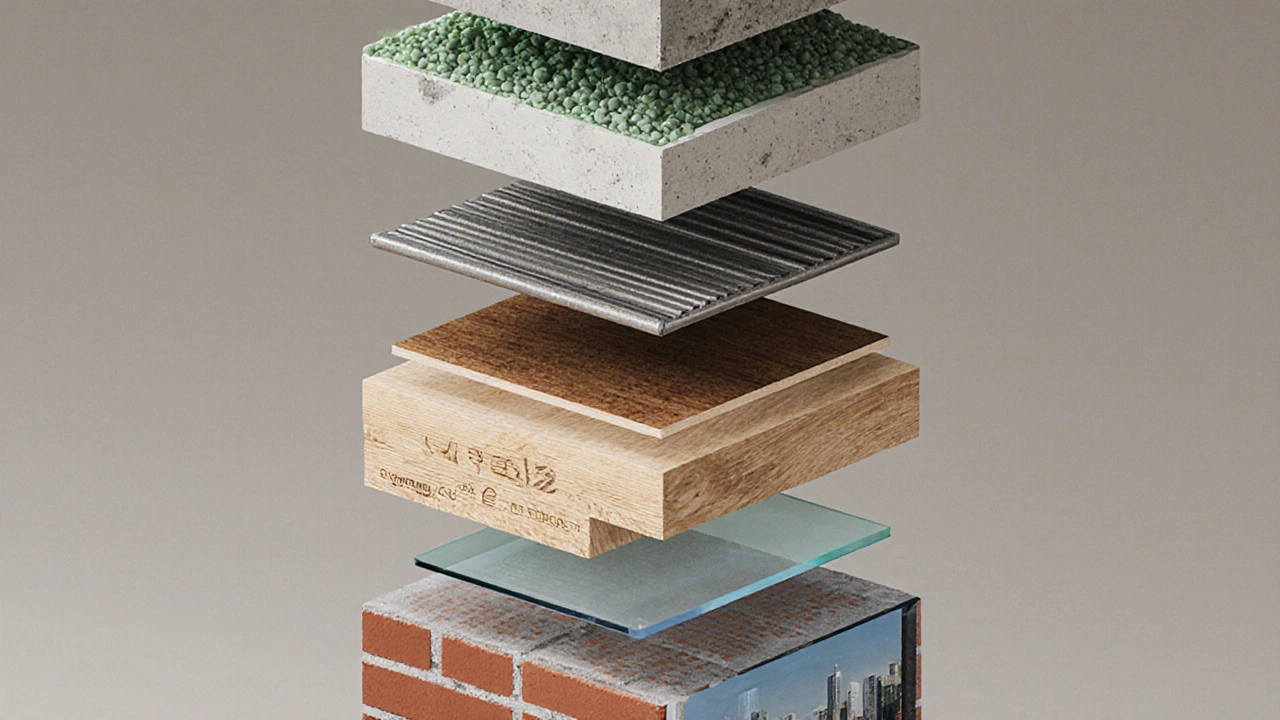
4. Brick is a fired clay unit that forms strong, fire‑resistant walls.
Traditional red brick walls provide excellent thermal mass, helping to moderate indoor temperatures. Standard modular bricks measure 190mm×90mm×57mm and cost about CAD0.75 each. Brick veneer is popular for aesthetic facades, while solid masonry is still used for load‑bearing exterior walls in low‑rise buildings.
5. Glass is a transparent or translucent silica‑based material used for windows, curtain walls, and façades.
Modern double‑glazed units offer R‑values around 0.3(m²·K)/W, dramatically better than single‑pane glass. Low‑emissivity (low‑E) coatings reflect infrared heat, improving energy efficiency in both hot and cold climates. In high‑rise towers, glass curtain walls can cover 70%+ of the façade surface area.
6. Gypsum Board (Drywall) is a panel composed of gypsum plaster sandwiched between paper facings.
Drywall is the standard interior wall finish in North America. A ½‑inch sheet spans 32sqft and weighs roughly 60lb. It provides fire resistance (TypeX boards achieve up to 1‑hour fire rating) and a smooth surface for paint or wallpaper.
7. Asphalt is a petroleum‑based binder mixed with aggregates to create pavement.
Used primarily for roadways, driveways, and roofing shingles, asphalt offers flexibility, quick installation, and relatively low cost (about CAD95 per tonne for hot mix). Recycled asphalt pavement (RAP) can replace up to 30% of virgin material, reducing waste.
8. Aluminum is a lightweight, corrosion‑resistant metal often extruded into framing or cladding profiles.
Aluminum’s strength‑to‑weight ratio makes it ideal for window frames, curtain‑wall mullions, and roofing panels. It costs roughly CAD2,300 per tonne, but its durability and low maintenance offset the price over a 30‑year service life.
9. PVC (Polyvinyl Chloride) is a synthetic plastic used for pipes, siding, and membrane roofing.
PVC pipe systems are favored for residential water supply and drainage because they’re lightweight, resistant to corrosion, and easy to join with solvent cement. Rigid PVC siding provides a low‑cost, low‑maintenance exterior finish, typically priced around CAD8 per square metre.
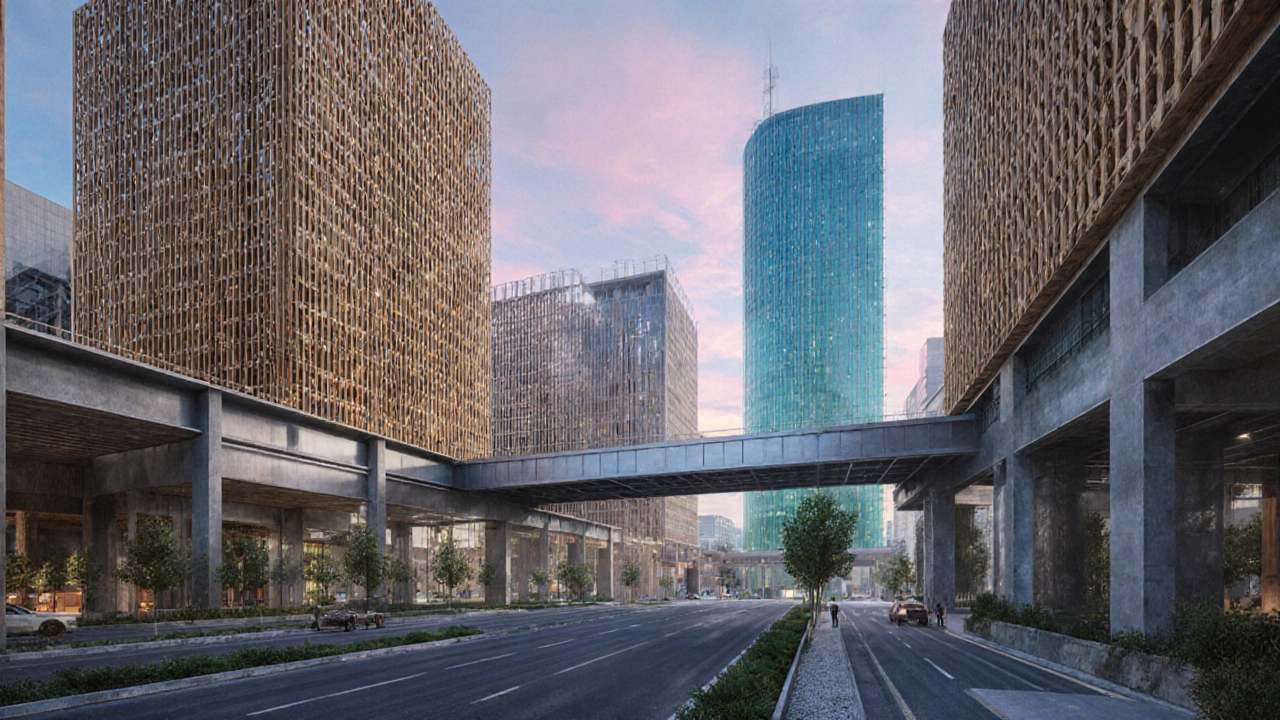
10. Stone is a natural rock such as granite, limestone, or sandstone, used for decorative cladding, flooring, and structural walls.
Stone offers unmatched durability and a timeless look. While more expensive (CAD150‑250 per square metre for finished granite), it’s often chosen for high‑traffic public spaces and heritage restorations.
Side‑by‑Side Comparison of Key Properties
| Material | Typical Compressive Strength (MPa) | Typical Tensile Strength (MPa) | Average Cost (CAD per unit) | Best Use Cases |
|---|---|---|---|---|
| Concrete | 30‑50 | 2‑5 | ≈120/m³ | Foundations, slabs, columns |
| Steel | 250‑500 | 350‑600 | ≈1,200/tonne | Frames, bridges, high‑rise cores |
| Wood (Lumber) | 8‑12 | 7‑10 | ≈3/board‑foot | Residential framing, CLT panels |
| Brick | 10‑35 | 1‑3 | ≈0.75/brick | Exterior walls, veneers |
| Glass | 0.7‑1.5 | 0.3‑0.6 | ≈45/m² (double‑glazed) | Windows, curtain walls |
| Gypsum Board | 0.5‑1.0 | 0.2‑0.5 | ≈10/sheet | Interior walls & ceilings |
| Asphalt | 5‑15 | 0.5‑1.5 | ≈95/tonne | Pavement, roofing shingles |
| Aluminum | 200‑400 | 150‑250 | ≈2,300/tonne | Window frames, cladding |
| PVC | 10‑30 | 2‑4 | ≈8/m² (siding) | Pipes, siding, roofing membrane |
| Stone | 40‑150 | 2‑5 | ≈150‑250/m² | Cladding, flooring, structural walls |
How to Pick the Right Material for Your Project
Start with three questions:
- What loads will the element carry? If you need high tensile strength-think steel or engineered wood. For sheer weight bearing, concrete or stone shine.
- What climate are you building in? Coastal or humid zones favor corrosion‑resistant steel, aluminum, or PVC. Cold climates benefit from high‑mass materials like concrete and brick to retain heat.
- What’s the budget and timeline? Wood and drywall are quickest and cheapest for interior work, while stone and high‑grade steel demand longer lead times and higher upfront costs.
After answering, run through this simple decision matrix:
- If speed and cost matter most → wood, drywall, PVC.
- If durability and fire resistance are critical → concrete, brick, stone.
- If structural span or high load is required → steel, engineered wood (LVL/CLT), aluminum.
- If aesthetics and light transmission dominate → glass and stone cladding.
Remember that many projects combine several materials. A typical suburban house in Halifax, for example, uses a concrete slab foundation, wood framing, drywall interiors, brick veneer, and double‑glazed windows.
Common Mistakes to Avoid
- Ignoring local building codes. Some municipalities restrict the use of certain masonry types in seismic zones.
- Choosing a material solely on price without accounting for life‑cycle costs-cheaper PVC may need replacement sooner than a stone façade.
- Under‑estimating moisture management. Wood and drywall need proper vapor barriers; otherwise you’ll face rot or mold.
- Skipping proper reinforcement. Even a strong material like concrete can crack if reinforcement isn’t designed for the expected loads.
Future Trends Shaping Material Choice
By 2030, the industry expects a 25% rise in low‑carbon concrete mixes, driven by stricter emissions regulations. Cross‑laminated timber is set to capture a larger share of mid‑rise projects as cities push for greener skylines. Recycled steel and reclaimed wood are gaining traction among developers chasing LEED certification.
Frequently Asked Questions
Which material offers the best fire resistance?
Concrete, brick, and stone have the highest fire‑rating because they don’t burn and can withstand high temperatures for extended periods. Gypsum board (TypeX) also provides a one‑hour fire rating when installed correctly.
Is wood still a viable choice for multi‑storey buildings?
Yes. Engineered products like CLT and Glulam deliver strength comparable to steel while offering a lower carbon footprint. Several European cities already have 8‑storey CLT towers in service.
How do I calculate the cost difference between steel and concrete framing?
Start with material prices per tonne (steel ≈CAD1,200, concrete ≈CAD120 per m³). Multiply by the volume needed for each component, then add formwork (for concrete) or decking (for steel). In most Canadian residential projects, concrete foundations are cheaper, but steel framing can reduce labor time, offsetting the higher material cost.
Can I mix recycled materials with traditional ones?
Absolutely. Recycled aggregates are common in concrete, reclaimed steel can be used for reinforcement, and reclaimed wood adds character to interior finishes. Always verify structural certifications and local code allowances.
What’s the most important factor when selecting exterior cladding?
Durability against weather and maintenance requirements. In coastal Halifax, aluminum and fiber‑cement siding resist salt corrosion, while brick offers natural weathering resistance but higher upfront cost.
Understanding the strengths and weaknesses of the common construction materials lets you balance cost, performance, and sustainability. Whether you’re drafting a simple remodel or planning a multi‑storey office block, the right material choices will keep your project on track and built to last.
